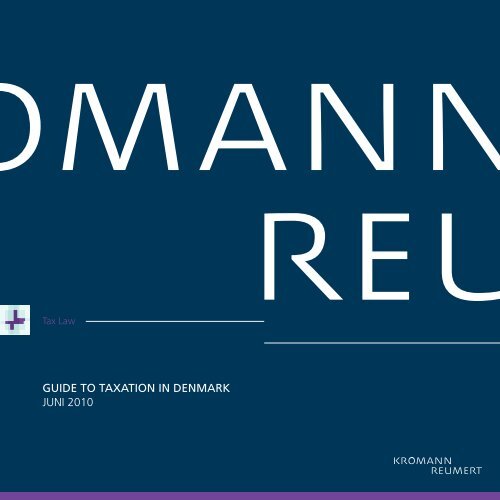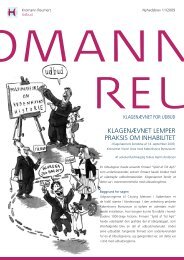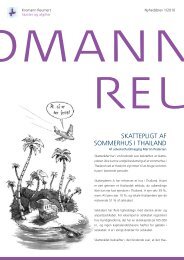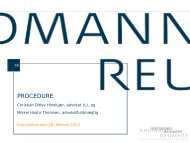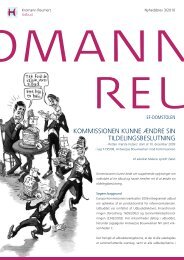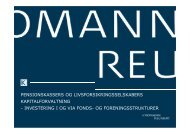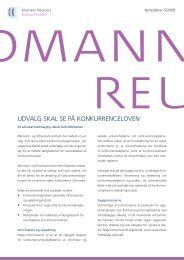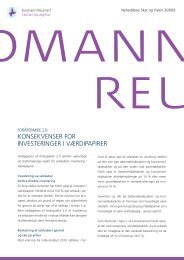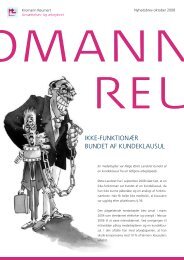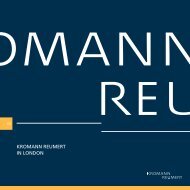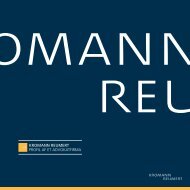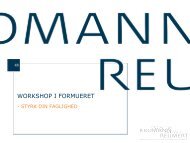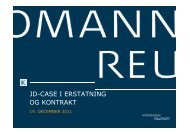GUIDE TO TAXATION IN DENMARK JUNI 2010 - Kromann Reumert
GUIDE TO TAXATION IN DENMARK JUNI 2010 - Kromann Reumert
GUIDE TO TAXATION IN DENMARK JUNI 2010 - Kromann Reumert
You also want an ePaper? Increase the reach of your titles
YUMPU automatically turns print PDFs into web optimized ePapers that Google loves.
Tax Law<br />
<strong>GUIDE</strong> <strong>TO</strong> <strong>TAXATION</strong> <strong>IN</strong> <strong>DENMARK</strong><br />
<strong>JUNI</strong> <strong>2010</strong><br />
3
1<br />
The <strong>Kromann</strong> <strong>Reumert</strong><br />
Tax Law Group<br />
<strong>Kromann</strong> <strong>Reumert</strong>’s tax law group offers Danish and international<br />
clients a focused range of advisory, planning, compliance and litigation<br />
services concerning Danish and international tax, VAT, customs and<br />
duties matters.<br />
Working in seamless integration with <strong>Kromann</strong> <strong>Reumert</strong>’s other practice<br />
groups and external partners we combine superior tax law competen-<br />
cies with industry insight and commercial acumen to provide innovative<br />
and integrated solutions.<br />
We prioritize research and development and contribute to the Danish<br />
and international tax communities as members, writers, teachers and<br />
speakers.
Contents<br />
1. THE DANISH TAX SYSTEM ................................. 6<br />
1.1 Types of Taxes ...................................................... 6<br />
1.2 Main Sources of Law ............................................ 6<br />
1.3 The Danish Tax Administration Structure .............. 6<br />
2. <strong>TAXATION</strong> OF CORPORATIONS ........................ 7<br />
2.1 Filing of Tax Returns and Payment of<br />
Corporation Taxes ................................................ 7<br />
2.2 Calculation of Income Taxes ................................. 7<br />
2.3 Transfer Pricing ................................................... 10<br />
2.4 Joint Taxation ......................................................11<br />
2.5 Intra-Group Contributions .................................. 12<br />
2.6 Territorial Rules ................................................... 12<br />
2.7 CFCs – Controlled Finance Companies ................ 13<br />
2.8 Anti-Avoidance Legislation ................................. 13<br />
2.9 Rules on Thin Capitalisation................................ 14<br />
2.10 Hybrid Instruments ............................................. 15<br />
2.11 Liquidation ......................................................... 15<br />
2.12 Limited Tax Liability and Withholding Taxes ........ 16<br />
3. <strong>TAXATION</strong> OF PARTNERSHIPS AND<br />
OTHER ENTITIES ............................................... 20<br />
3.1 Partnerships ....................................................... 20<br />
3.2 European Economic Interest Grouping (EEIG) ..... 20<br />
3.3 Foundations and Associations ............................ 20<br />
3.4 Production and Marketing Cooperatives ............. 21<br />
3.5 Investment Associations ..................................... 21<br />
3.6 Pension Funds .................................................... 22<br />
4. <strong>TAXATION</strong> OF <strong>IN</strong>DIVIDUALS ........................... 23<br />
4.1 Tax Liability ......................................................... 23<br />
4.2 Tax Rates ............................................................ 23<br />
4.3 Filing of Tax Returns and Payment of Taxes ......... 23<br />
4.4 Calculation of Taxable Income ............................ 23<br />
4.5 Employee Equity Plans ........................................ 24<br />
4.6 Expatriate Tax Regime ........................................ 25<br />
5. OTHER TAXES ................................................... 26<br />
5.1 Special Gas and Oil Tax ....................................... 26<br />
5.2 Danish Maritime Tonnage Tax ............................. 26<br />
5.3 Value Added Tax ................................................ 26<br />
5.4 Payroll Tax .......................................................... 26<br />
5.5 Excise Duties and Green Taxes ............................ 26<br />
5.6 Registration Duties ............................................. 26<br />
5.7 Stamp Duty ........................................................ 26<br />
5.8 Social Security, Healthcare and Other<br />
Welfare System Contributions ............................ 27<br />
5.9 Property Taxes .................................................... 27<br />
5.10 Inheritance and Gift Tax ..................................... 27<br />
6. B<strong>IN</strong>D<strong>IN</strong>G RUL<strong>IN</strong>GS ............................................ 28<br />
7. TAX TREATIES ................................................... 28<br />
8. DISCLAIMER ..................................................... 32
1. The Danish Tax System<br />
1.1 TYPES OF TAXES<br />
The Danish tax system comprises of direct and indirect taxes.<br />
Direct taxes include income tax and property tax, while the<br />
principal indirect taxes are value added tax (VAT), customs, green<br />
taxes and excise duties.<br />
The Danish income tax for companies is a flat rate corporation tax<br />
of 25 percent.<br />
The income taxes for individuals are state tax, municipal tax, health<br />
tax and church tax. The state tax is a progressive tax divided into<br />
bottom-bracket and top-bracket tax rates. The municipal, health,<br />
and church taxes are calculated on a flat rate basis. The church tax<br />
is payable by members of the Danish National Evangelical Lutheran<br />
Church (Folkekirken). Individuals also have to make contributions<br />
to a labour market pension fund.<br />
Aside from taxes on personal income, Denmark applies taxes to<br />
share income and capital gains on, for example, real property, and<br />
other income from investments.<br />
The Danish government levies a number of other taxes, such as,<br />
for example, property taxes, property value tax, taxes on gifts<br />
and inheritance, payroll tax, special gas and oil taxes and tonnage<br />
taxes – as described below.<br />
On 28 May 2009, the Danish Parliament approved a major reform<br />
to Danish tax law (entitled Forårspakke 2.0 or in English, Spring<br />
Package 2.0). The primary purpose of the tax reform was to reduce<br />
the taxation of employment income, which, for Denmark, is still<br />
set at one of the highest levels in the world, with a marginal tax<br />
rate of 56.5 percent including social contributions. However,<br />
6<br />
the tax reform also has significant tax consequences for Danish<br />
businesses.<br />
1.2 MA<strong>IN</strong> SOURCES OF LAw<br />
The main source of Danish tax law is the 1922 statute on income<br />
taxation to the state (Statsskatteloven) which includes the<br />
fundamental principles of Danish tax law. However, over the<br />
last 88 years, different Danish governments have introduced<br />
numerous acts governing tax matters, which today make taxation<br />
in Denmark a particularly complex matter.<br />
1.3 THE DANISH TAX ADM<strong>IN</strong>ISTRATION STRUCTURE<br />
In Denmark, taxes are administered through the Danish Tax and<br />
Customs Administration (SKAT), which was formed on 1 November<br />
2005 following a merger between the municipal and state tax<br />
administrations. The Danish Tax and Customs Administration is a<br />
single administrative body with a number of units located across<br />
the country. It employs around 8,000 staff.<br />
Apart from the Ministry of Taxation and the Danish Tax and<br />
Customs Administration, the Danish tax authorities include a Tax<br />
Council, a National Tax Tribunal and a number of local tax and tax<br />
assessment tribunals.<br />
2. Taxation of corporations<br />
Corporations resident in Denmark are liable to pay corporate tax<br />
on their worldwide income. However, income from permanent<br />
establishments and real property located abroad is not taxable<br />
income.<br />
There are two forms of corporations in Denmark – private limited<br />
companies (in Danish, anpartsselskab, which can be abbreviated<br />
to ApS), and public limited companies (in Danish, aktieselskab,<br />
which can be abbreviated to A/S).<br />
In addition to Danish corporations, a number of other business<br />
entities – including certain other limited liability companies and<br />
associations – are subject to corporate taxation in Denmark.<br />
2.1 FIL<strong>IN</strong>G OF TAX RETURNS AND PAYMENT OF CORPORATION<br />
TAXES<br />
As a general rule, the income year for companies is the calendar<br />
year. However, companies are also permitted to select an income<br />
year that differs from the calendar year. Companies included<br />
under joint taxation (see item 2.4) must have the same tax year as<br />
the administrative company.<br />
A yearly tax return must be filed with the tax authorities within<br />
6 months following the end of the fiscal year. However, if a<br />
company’s nominated tax year ends between 1 February and 31<br />
March, its tax return must be filed on or before 1 August in the<br />
relevant year.<br />
Companies pay taxes on a current year basis. Taxes are due as<br />
account payments on 20 March and 20 November.<br />
2.2 CALCULATION OF <strong>IN</strong>COME TAXES<br />
2.2.1 THE TAx RATE<br />
Danish corporations are taxed at a flat rate of 25 percent.<br />
2.2.2 TAxAbLE <strong>IN</strong>COME<br />
In general, any income is taxable if it is subject to full tax liability.<br />
As a rule, capital gains are added to the taxable income, as<br />
described below.<br />
2.2.2.1 Capital gains on shares<br />
The 2009 tax reform has significantly changed the Danish<br />
participation regime with effect from the income year <strong>2010</strong>.<br />
The tax reform introduced a distinction between “subsidiary<br />
shares”, “group shares” and “portfolio shares”.<br />
“Subsidiary shares” are shares where (i) the corporate shareholder<br />
owns at least 10 percent of the shares in another company, and<br />
(ii) the company is a Danish company subject to corporate tax, or<br />
a foreign company where the taxation of any dividends it pays<br />
out must be waived or reduced according to the Parent-Subsidiary<br />
Directive (Directive 90/435/EEC) or a tax treaty between Denmark<br />
and the jurisdiction where the foreign company is a tax resident.<br />
“Group shares” are shares where the corporate shareholder and<br />
the company are subject to Danish national joint taxation or could<br />
elect to be subject to Danish international joint taxation (generally,<br />
this requires that the corporate shareholder controls more than 50<br />
percent of the votes in the company).<br />
“Portfolio shares” are shares that do not qualify as subsidiary<br />
shares or group shares.<br />
Capital gains on subsidiary shares and group shares are generally<br />
7
exempt from taxation, while capital gains on portfolio shares are<br />
generally taxable (at the full corporate tax rate of 25 percent).<br />
Further, capital gains on portfolio shares are – as a starting point<br />
– taxed annually on a mark-to-market basis. However, corporate<br />
taxpayers may opt for taxation on a realization basis in relation to<br />
shares that are not traded on a regulated market.<br />
Losses in respect of subsidiary shares and group shares are not<br />
deductible. Losses relating to portfolio shares can be deducted<br />
from the taxable income. However, if the taxpayer has opted for<br />
taxation on a realization basis, losses may only be set off against<br />
gains on shares that are taxed on that basis.<br />
The ownership period is no longer decisive for the taxation of<br />
capital gains on shares.<br />
Anti-avoidance provisions and a number of transitional rules<br />
that apply to shares acquired prior to <strong>2010</strong> have increased the<br />
complexity of Danish capital gains taxation.<br />
In order to counter structures where two or more corporate<br />
shareholders with shareholdings below the 10 percent threshold<br />
pool their shares in a joint holding company (to reach the 10<br />
percent threshold), an anti-avoidance rule has been introduced.<br />
According to this rule, subsidiary shares or group shares held by a<br />
holding company are for tax purposes deemed to be held by the<br />
shareholders of the holding company if the following cumulative<br />
conditions are met:<br />
• the primary function of the holding company is to own subsidiary<br />
shares and group shares,<br />
• the holding company does not carry out genuine economic<br />
business activities in relation to the shareholding,<br />
• more than 50 percent of the shares in the holding company<br />
8<br />
are – directly or indirectly – owned by Danish resident<br />
companies (or a Danish permanent establishment of a<br />
foreign company) that would be unable to receive tax-free<br />
dividends in case of direct ownership of the shares owned<br />
by the holding company, and<br />
• the shares in the holding company are not listed on a regulated<br />
market or a multilateral trading facility.<br />
2.2.2.2 Capital gains and bonds, debentures and financial<br />
contracts etc.<br />
Companies are subject to tax on all capital gains and losses on<br />
bonds, debentures and similar financial instruments, and on debts,<br />
irrespective of the currency and the interest rate. Capital gains on<br />
futures, options and other financial instruments are also subject<br />
to tax.<br />
Structured bonds are generally taxed pursuant to the rules<br />
applicable to derivatives. A bond is for Danish tax purposes<br />
considered to be structured if the principle in whole or in part<br />
is adjusted in accordance with prices or other factors related to<br />
securities, goods or other assets.<br />
Capital gains on convertible bonds are, however, treated as capital<br />
gains on shares. Also, special rules apply to inter-company debt<br />
between affiliated companies.<br />
Following the 2009 tax reform, gains and losses on most types of<br />
bonds held by companies are taxed annually on a mark-to-market<br />
basis.<br />
2.2.2.3 Capital gains on real property<br />
Capital gains on real property are generally taxable. For certain<br />
properties used for business purposes, roll-over relief is available in<br />
connection with the sale and re-purchase of real property.<br />
2.2.2.4 Goodwill and intangible rights<br />
Capital gains on goodwill and other intangible rights are taxable<br />
income.<br />
2.2.3 DEDUCTIONS AND DEPRECIATION<br />
2.2.3.1 Deductions<br />
Trading losses and interest expenses may be set off against other<br />
income and gains.<br />
2.2.3.2 Depreciation<br />
Depreciation on machinery is calculated by pooling the value<br />
of all such items and then using the declining-balance method.<br />
A company may use a depreciation rate from 0% to 25%.<br />
Depreciation cannot be claimed in the year of disposal. Machinery<br />
and equipment with a purchase price of less than DKK 12,300<br />
(<strong>2010</strong>) or an estimated life span of less than 3 years may be fully<br />
depreciated in the year of acquisition.<br />
Expenditures relating to the acquisition of computer software may<br />
be fully depreciated in the year of acquisition.<br />
Assets used for leasing activities are governed by special rules.<br />
A company acquiring machinery and equipment for leasing<br />
purposes is not allowed to claim depreciation on leased assets in<br />
the acquiring year. In the following year, 50% may be depreciated.<br />
The tax authorities may allow the normal depreciation rules to be<br />
applied.<br />
buildings used for production or other business purposes – but<br />
not offices – may, as a main rule, be depreciated on a straight-line<br />
basis by 4% annually.<br />
Acquired goodwill and other intangible properties such as patents<br />
and trademarks may be depreciated by up to one-seventh of their<br />
acquisition value per year. If the right in question allows its owner<br />
a period of exclusivity of less than 7 years, the acquired right may<br />
be depreciated by the same percentage amount each year, where<br />
that annual rate is calculated using the value of the acquisition<br />
during the remaining period of exclusivity.<br />
Acquired know-how and patents may be fully deducted in the year<br />
of acquisition.<br />
Infrastructure assets for transportation, the storing and distribution<br />
of electricity, water, heat, oil, gas and sewage, the transmission of<br />
radio and television and telecommunications equipment (except<br />
for IT hardware and software), and railway assets or similar may be<br />
depreciated by 7%.<br />
For certain ships, planes, railway equipment, heat and electricity<br />
production assets, drilling rigs and various hydrocarbon-related<br />
assets, the depreciation rate will be reduced gradually from 25%<br />
to 15% as follows:<br />
2007: 25%<br />
2008 - 2009: 23%<br />
<strong>2010</strong> - 2011: 21%<br />
2012 - 2013: 19%<br />
2014 - 2015: 17%<br />
2016: 15%<br />
Licenses for the exploration and exploitation of oil and gas are to<br />
be depreciated over the lifetime of the licenses.<br />
2.2.4 TAx LOSSES<br />
Losses may be carried forward indefinitely. Carry-back is not<br />
possible.<br />
9
The right to set off losses carried forward against other income<br />
may disappear or be reduced if more than 50% of the shares in<br />
the company have changed ownership since the beginning of<br />
the year in which the losses were incurred, or if the company has<br />
obtained a remission of debt, composition or similar.<br />
2.2.5 TAxATION OF DIVIDENDS<br />
Dividends received by a Danish parent company from Danish or<br />
foreign subsidiaries are generally tax-exempt. However, this tax<br />
exemption only covers dividends from subsidiary shares or group<br />
shares.<br />
“Subsidiary shares” are shares where (i) the corporate shareholder<br />
owns at least 10 percent of the shares in another company, and<br />
(ii) the company is a Danish company subject to corporate tax or<br />
a foreign company where the taxation of any dividends it pays<br />
out must be waived or reduced according to the Parent-Subsidiary<br />
Directive or a tax treaty between Denmark and the jurisdiction<br />
where the foreign company is a tax resident.<br />
“Group shares” are shares where the corporate shareholder and<br />
the company are subject to Danish national joint taxation or could<br />
elect to be subject to Danish international joint taxation (generally,<br />
this requires that the corporate shareholder controls more than 50<br />
percent of the votes in the company).<br />
Previously, the tax exemption for dividends only applied for<br />
companies that had held shares in a subsidiary for a period of at<br />
least 12 months, and the dividend was declared during this period.<br />
However, following the 2009 tax reform this requirement has<br />
been abolished with effect from the tax year <strong>2010</strong>.<br />
The exemption also applies to foreign companies with a permanent<br />
establishment in Denmark. However, it is a condition that the<br />
10<br />
company is domiciled within the EU or EEA, in the Faroe Islands<br />
or Greenland or in a state that has concluded a tax treaty with<br />
Denmark.<br />
The tax exemption does not cover dividends if the company paying<br />
such dividends is allowed to deduct the distribution of dividends.<br />
However, the distribution of dividends is still tax-exempt if foreign<br />
taxation is waived or reduced pursuant to the Parent-Subsidiary<br />
Directive and common taxation schemes for parent companies<br />
and subsidiaries from different member states.<br />
Dividends received from investment companies are not tax-exempt<br />
– see 3.5, below.<br />
2.3 TRANSFER PRIC<strong>IN</strong>G<br />
The Danish transfer pricing legislation is based on the general<br />
principle of arm’s length transactions.<br />
Accordingly, all transactions between connected parties must<br />
be concluded on general market terms as if the parties to the<br />
transactions were independent entities (transactions must be<br />
concluded at “arm’s length”). A “connection” exists between<br />
parties if a company or an individual (or a group of affiliated<br />
companies or related persons) owns, directly or indirectly, more<br />
than 50% of the shares in the relevant company or may exercise<br />
more than 50% of the votes in the relevant company.<br />
In order to catch private equity funds and similar arrangements,<br />
the definition not only includes companies but also extends to:<br />
• Entities and associations which are fiscally transparent under<br />
Danish tax law and which are governed by the rules of corporate<br />
law, a corporate agreement or articles of association.<br />
• Entities with joint management.<br />
• Entities that have entered into an agreement regarding the<br />
exercise of a joint controlling influence.<br />
The Danish practice in the transfer pricing field is generally in<br />
accordance with the OECD Guidelines.<br />
The Danish Parliament has adopted rules on transfer pricing<br />
documentation. The legislation states that affiliated companies<br />
must provide information in their tax return evidencing the nature<br />
and extent of any transactions with associated enterprises. In order<br />
to ensure compliance with the arm’s length principle, connected<br />
parties are subject to a duty of disclosure (i.e. a duty to provide<br />
information in the tax return about the nature and extent of<br />
controlled transactions), and a duty to provide documentation (i.e.<br />
a duty to prepare written documentation describing how prices<br />
and other terms have been fixed).<br />
The duty of disclosure and the duty to provide documentation<br />
only apply to companies or similar entities that are subject to the<br />
special tonnage tax regime, to the extent that the income of such<br />
companies is not covered by the regime.<br />
Further, a general exemption applies to small and medium-sized<br />
companies. Such companies are only obliged to prepare transfer<br />
pricing documentation in respect of controlled transactions<br />
entered into with companies in countries outside the EU or the<br />
EEA and with which Denmark has not entered into a tax treaty.<br />
Also, a general exemption applies to controlled transactions that<br />
are deemed immaterial in respect of either volume or frequency.<br />
The documentation must be in writing and of a nature that can<br />
provide the basis for an evaluation as to whether the prices and<br />
conditions have been determined at arm’s length. The enterprise<br />
must explain which method or methods were used in order to<br />
arrive at the arm’s length price.<br />
Non-compliance with the requirement to provide documentation<br />
is punishable by fine, provided that the non-compliance can<br />
be characterised as wilful or grossly negligent. Furthermore,<br />
companies that have not prepared documentation risk a<br />
discretionary assessment of their taxable income.<br />
The tax authorities are afforded the opportunity to commence a<br />
taxation case concerning transfer pricing issues for a period of up<br />
to 5 years and 4 months after the expiry of the relevant tax year.<br />
The Danish Tax and Customs Administration has recently increased<br />
its focus on transfer pricing issues and has decided on a number<br />
of major income adjustments based on the transfer pricing rules.<br />
2.4 JO<strong>IN</strong>T <strong>TAXATION</strong><br />
According to the Danish joint taxation regime, all Danish group<br />
companies and all permanent establishments and real properties<br />
in Denmark owned by foreign group companies are automatically<br />
taxed on a joint basis. The consolidated taxable income will<br />
be calculated as the sum of the taxable income of each group<br />
company, irrespective of whether or not the group company is<br />
wholly owned or not.<br />
International joint taxation (i.e. joint taxation with foreign group<br />
companies) is optional. However, if a group opts for international<br />
joint taxation, all foreign group companies as well as all permanent<br />
establishments and real property in foreign countries owned by<br />
group companies will have to be included in the joint taxation.<br />
Therefore, it is not possible to include only some foreign group<br />
companies in Danish joint taxation.<br />
If international joint taxation is selected, that choice will be<br />
11
inding on the group for a period of 10 years. However, a group<br />
may choose to terminate international joint taxation prior to the<br />
expiry of the 10-year period against taxation of the full amount of<br />
losses deducted under the joint taxation.<br />
As part of the joint taxation, a so-called “administrative company”<br />
must be appointed. The administrative company must be the<br />
Danish group parent company. The main duty of the administrative<br />
company is payment of the tax levied on the consolidated taxable<br />
income of the group. In return, any other Danish group companies<br />
must pay to the administrative company an amount equal to their<br />
portion of the tax levied on the consolidated taxable income of the<br />
group. Similarly, foreign group companies can pay their portion of<br />
the tax levied on the consolidated taxable income of the group<br />
to the administrative company, but are not obliged to do so. As a<br />
starting point, each group company is only liable for its portion of<br />
the tax levied on the consolidated taxable income of the group.<br />
However, the administrative company assumes tax liability for the<br />
Danish group companies upon receipt of payment of the respective<br />
portions of the consolidated taxable income of the group.<br />
Group companies include all companies (with minor exceptions)<br />
that qualify as group companies within the meaning of the Danish<br />
Corporation Tax Act (Selskabsskatteloven).<br />
This means that a company (the subsidiary) is deemed to be part<br />
of the same group as another company (the parent company) if<br />
the parent company holds the majority of the voting rights in the<br />
subsidiary, may appoint or remove a majority of the members of<br />
the senior body of the subsidiary, or is able to control the subsidiary<br />
in any other way.<br />
2.5 <strong>IN</strong>TRA-GROUP CONTRIBUTIONS<br />
As a general rule, contributions – other than capital contributions<br />
made in connection with increases in share capital, including<br />
premiums – are included in the taxable income for the recipients<br />
and are non-deductible for the grantors (unless, as an exception,<br />
the contribution can be substantiated as a business cost incurred<br />
in the interests of the grantor).<br />
However, contributions from a company which is under joint<br />
taxation or could have been under joint taxation with the recipient<br />
company (see above, under item 2.4) may be received as taxexempt.<br />
On the other hand, the grantor of the contribution cannot<br />
deduct the contribution.<br />
Contributions are only tax-exempt if the grantor is directly or<br />
indirectly the parent company to the recipient company, or if the<br />
grantor and the recipient company have a joint parent company<br />
(and are therefore sister companies).<br />
Further, contributions between sister companies are only tax<br />
exempt if the grantor could have distributed tax-exempt dividends<br />
to the common parent company, see item 2.2.5 above. If the<br />
parent company is not a Danish entity, it must be covered by the<br />
provisions of the Parent-Subsidiary Directive or by a tax treaty,<br />
according to which the Danish taxation of dividends paid to such a<br />
foreign company must be waived or reduced.<br />
A contribution is not tax exempt if it can be deducted by an<br />
affiliated company outside Denmark or if the grantor is an<br />
investment company.<br />
2.6 TERRI<strong>TO</strong>RIAL RULES<br />
A company that is either registered with the Danish Commerce<br />
and Companies Agency or is effectively managed in Denmark is<br />
subject to full tax liability. Effective management is interpreted in<br />
accordance with the same principle as the OECD Model Treaty and<br />
generally refers to the place where the day-to-day management<br />
decisions are made.<br />
Danish companies are generally subject to taxation on their<br />
worldwide income.<br />
However, Danish companies are not subject to taxation on<br />
income related to permanent establishments or real property in<br />
foreign countries except except (i) in respect of income from the<br />
operation of ships or aircraft in international traffic, or (ii) when<br />
Denmark has been granted the taxation right by a tax treaty or<br />
other international agreement.<br />
Permanent establishments or real property in foreign countries<br />
will, however, be included under Danish taxation if the company<br />
is part of international joint taxation – see item 2.4. Further, the<br />
CFC regime (see item 2.7) applies to permanent establishments<br />
of Danish companies and, therefore, a Danish company will<br />
be subject to taxation on any taxable income attributable to a<br />
permanent establishment in a foreign country, provided that the<br />
CFC conditions are met.<br />
A company which is not subject to full tax liability to Denmark<br />
may be subject to limited tax liability – see item 2.12 below.<br />
2.7 CFCS – CONTROLLED F<strong>IN</strong>ANCE COMPANIES<br />
As from 1 July 2007, the Danish CFC regime for companies was<br />
amended substantially in order to bring the Danish rules in line<br />
with the principles set out by the European Court of Justice in<br />
the Cadbury Schweppes case (C-196/04).<br />
Since July 2007, the CFC regime has been extended to apply<br />
not just to foreign companies, but to all subsidiaries meeting<br />
a revised CFC test, i.e. irrespective of their tax residency and<br />
irrespective of the taxation actually applied to the subsidiaries.<br />
Companies will only be deemed CFCs if they are (i) controlled<br />
by a Danish parent, (ii) have financial income (such as interest,<br />
dividends, royalties, and capital gains on shares, debts, and<br />
financial instruments etc.) constituting more than half of their total<br />
income, and (iii) have financial assets constituting more than 10%<br />
of their total assets.<br />
A company’s financial income and financial assets are calculated<br />
on a consolidated basis together with any subsidiaries located in<br />
the same jurisdiction.<br />
The total income of a CFC will be included in the taxable income<br />
of the Danish parent and relief will be granted for tax payments<br />
made by the CFC.<br />
Insurance companies, banks and mortgage credit institutes<br />
with substantial activities in foreign jurisdictions may apply for<br />
exemption from CFC taxation.<br />
The CFC regime also applies to permanent establishments of<br />
Danish companies. Therefore, a Danish company will be subject<br />
to taxation on any positive CFC income from a permanent<br />
establishment in a foreign country, provided that the CFC<br />
conditions are met.<br />
The CFC rules do not apply to subsidiaries that are included under<br />
international joint taxation or which are investment companies.<br />
2.8 ANTI-AVOIDANCE LEGISLATION<br />
A change of domicile by a Danish company or taxable legal entity<br />
will usually be considered as liquidation with the same taxation<br />
effect as a sale. A company may move its activities abroad, but to<br />
12 13
ensure that there is no tax avoidance, such a transfer is considered<br />
a disposal.<br />
2.9 RULES ON TH<strong>IN</strong> CAPITALISATION<br />
The Danish Corporation Tax Act has included rules on thin<br />
capitalisation since 1998. However, on 1 June 2007 the Danish<br />
Parliament adopted a bill which introduced two new rules<br />
limiting the deductibility of interest. These new rules – an interest<br />
ceiling and an EbIT (Earnings Before Interest and Taxes) model –<br />
supplement the thin capitalisation rules.<br />
The new “interest ceiling” and “EbIT model” took effect from 1<br />
July 2007. Three tests now have to be made in order to determine<br />
the actual deductibility of net financing costs:<br />
1. The thin capitalization test<br />
2. The “interest ceiling” test<br />
3. The “EBIT model” test.<br />
2.9.1 TH<strong>IN</strong> CAPITALISATION<br />
The Danish rules on thin capitalisation apply to Danish legal entities<br />
which have debt (debt is defined as the aggregate of controlled<br />
debt and third party debt) to Danish or foreign legal entities that<br />
either control the Danish entity, are being controlled by the Danish<br />
entity, or are under joint “control” together with the Danish entity<br />
(“controlled debt”).<br />
Control exists if a company or an individual (or a group of affiliated<br />
companies or related persons) owns, directly or indirectly, more<br />
than 50% of the shares in the relevant company or may exercise<br />
more than 50% of the votes in the relevant company. The<br />
definition of “control” also includes:<br />
• Entities and associations that are fiscally transparent under<br />
Danish tax law but are governed by the rules of corporate law, a<br />
corporate agreement or articles of association.<br />
• Entities with joint management.<br />
• Entities that have entered into an agreement regarding the<br />
exercise of a joint controlling influence.<br />
Controlled debt also includes third party loans which have been<br />
guaranteed by the controlling shareholder(s) or its affiliates.<br />
If the debt-equity ratio exceeds 4:1, the interest on the excess<br />
part of the controlled debt is not deductible if the controlled debt<br />
exceeds DKK 10 million. However, the limitation only applies to<br />
that part of the debt which should have been equity in order to<br />
avoid the limitation.<br />
As an exception to the main rule, interest can be deducted if the<br />
taxpayer is able to show that a similar loan could be obtained<br />
from an independent third party without any security from the<br />
controlling shareholder(s) or its affiliates.<br />
If the total debt is comprised of controlled debt and debt to an<br />
independent third party, the limitation on deductibility will only<br />
apply for the interest on the controlled debt.<br />
The interest that cannot be deducted is not requalified as dividends.<br />
Therefore, no withholding tax applies for such payments.<br />
2.9.2 <strong>IN</strong>TEREST CEIL<strong>IN</strong>G<br />
According to the “interest ceiling”, net financing costs exceeding a<br />
ceiling calculated as a standard rate of return (variable, at present<br />
5% p.a.) on the tax value of the company’s assets and exceeding an<br />
annual minimum relief of DKK 21,300,000 (adjusted annually) are not<br />
deductible. Accordingly, interest (and other financing costs) below<br />
the annual minimum relief of DKK 21,300,000 (<strong>2010</strong>) are always<br />
deductible, unless limited by the existing thin capitalisation rules.<br />
Net financing costs are defined as the negative sum of interest<br />
income and interest expenses, deductible and taxable loan<br />
commissions, gains and losses on debt claims and financial<br />
contracts (with certain exceptions), the interest element of<br />
financial leasing and taxable dividends, taxable capital gains<br />
and offset losses on shares. Net financing costs include interest<br />
irrespective of whether the interest relates to intra-group debt or<br />
external debt.<br />
The tax value of the company’s assets basically consists of the<br />
depreciated value of depreciable assets, the cost base of other<br />
assets and carry-forward losses, excluding the value of cash, debt<br />
claims, financial contracts and shares.<br />
However, only 20% of the acquisition price for shares in directly<br />
owned subsidiaries not subject to joint taxation is included in the<br />
tax value, subject to complex adjustment mechanisms. As all Danish<br />
group companies are automatically taxed jointly, this provision will<br />
in practice only be relevant in relation to foreign subsidiaries.<br />
As part of the substantial 2009 tax reform, this 20% rule will be<br />
gradually phased out between <strong>2010</strong> and 2017, thereby effectively<br />
rendering financing expenses related to acquisitions of shares in<br />
foreign companies as non-deductible.<br />
Calculation of the tax value is made on a consolidated basis for<br />
companies that are taxed jointly. Assets contributed by a foreign<br />
affiliated company are only included in the tax value if the assets<br />
remain in the company for at least two years, unless international<br />
joint taxation is opted for.<br />
2.9.3 EbIT MODEL<br />
From 1 July 2007, an “EBIT model” has been introduced,<br />
maximising the deductibility of net financing costs to 80% of EbIT<br />
(Earnings Before Interest and Taxes). However, deduction of net<br />
financing costs not exceeding DKK 21,300,000 (<strong>2010</strong>) is always<br />
allowed.<br />
2.10 HYBRID <strong>IN</strong>STRUMENTS<br />
If a company owes debt to a person or company abroad and the<br />
tax laws in the foreign country class the debt as equity, the debt<br />
will also be treated as equity for the purposes of Danish taxation.<br />
Therefore, the interest cannot be deducted by the Danish company.<br />
Instead, any interest and capital gains relating to the “debt” will be<br />
treated as dividends for Danish tax purposes.<br />
2.11 LIqUIDATION<br />
A Danish company is liable to pay Danish tax until it is finally<br />
dissolved. The fact that a Danish company goes into liquidation<br />
does not affect the company’s tax liability.<br />
When the company disposes of its assets under liquidation, all<br />
gains are taxable according to the general rules described above.<br />
Further, any shareholders who are liable to pay tax in Denmark<br />
will be liable for taxation on any capital gains on the shares or any<br />
distributions of surplus remaining on winding up.<br />
As a general rule, remaining surplus on winding up that is<br />
distributed in the calendar year where the liquidating company is<br />
finally dissolved is taxed as capital gains (see item 2.2.2.1), whereas<br />
surplus distributed prior to this year is treated as dividends (see<br />
item 2.2.5).<br />
However, surplus left on winding up that is distributed in the<br />
calendar year where the liquidating company is finally dissolved<br />
will be taxed as dividends, if (i) the recipient company owns at<br />
least 10% of the share capital of the liquidating company but<br />
14 15
is not a resident of the EU/EEA, the Faroe Islands, Greenland or<br />
a Danish treaty partner, or (ii) the recipient company owns less<br />
than 10% of the share capital in the liquidating company (but is<br />
affiliated with the liquidating company).<br />
On the other hand, surplus left on winding up that is distributed<br />
prior to the calendar year in which the liquidating company is<br />
finally dissolved is taxed according to the rules for capital gains<br />
on shares for shareholders that carry on trade by the sale and<br />
purchase of shares and which would otherwise be entitled to<br />
receive tax-exempt dividends.<br />
2.12 LIMITED TAX LIABILITY AND wITHHOLD<strong>IN</strong>G TAXES<br />
Foreign companies that are not subject to full tax liability in<br />
Denmark may be subject to limited tax liability with respect to<br />
income and gains deriving from certain sources in Denmark.<br />
Limited tax liability for companies applies to, for example, income<br />
from permanent establishments, immovable property situated in<br />
Denmark, and dividends, royalties and interest distributed from<br />
sources in Denmark and certain capital gains on debt claims.<br />
2.12.1 WITHHOLD<strong>IN</strong>G TAxES<br />
2.12.1.1 Dividends<br />
As a general rule, dividends distributed from a Danish company to<br />
a foreign shareholder are subject to 27% withholding tax.<br />
However, the withholding tax is reduced or removed completely<br />
by way of an exemption for dividends paid to a foreign parent<br />
company where the parent company holds “subsidiary shares” or<br />
“group shares” (as defined above in item 2.2.21) and if the foreign<br />
parent company is resident in another EU country, or in a country<br />
with which Denmark has entered into a tax treaty according to<br />
which Denmark must grant relief or reduction from withholding tax.<br />
Most of the tax treaties concluded between Denmark and other<br />
countries state that the Danish withholding tax on dividends is<br />
reduced.<br />
Further, the withholding tax does not include dividends received<br />
by participants in parent companies named in the list of companies<br />
under Article 2(1)(a) of the Parent-Subsidiary Directive, and which<br />
are considered transparent entities in respect of Danish taxation.<br />
It is a condition that the company participant is not domiciled in<br />
Denmark.<br />
In the opinion of the Danish Tax and Customs Administration, the<br />
benefit of the exemption may be denied with respect to dividends<br />
distributed by Danish companies to intermediary holding<br />
companies if in reality the dividends flow through that entity to<br />
another entity resident in a “tax haven” jurisdiction. In recent<br />
years, the Danish Tax and Customs Administration has adopted<br />
an approach that actively scrutinizes such beneficial ownership<br />
issues. They are preparing a number of cases on this issue.<br />
2.12.1.2 Royalties<br />
Withholding tax is also applicable to royalties. A 25% tax is<br />
withheld from royalty payments deriving from Denmark in relation<br />
to patents, trademarks, technical know-how etc. This withholding<br />
tax may be reduced under a tax treaty. The withholding tax<br />
does not apply if the royalties are attributable to the receiver’s<br />
permanent Danish establishment, or the receiver is subject to the<br />
protection of the EU Interest/Royalty Directive (Directive 2003/49/<br />
EEA), which prohibits EU member states from retaining withholding<br />
tax on royalty and interest payments between affiliated companies<br />
within the EU.<br />
A company is considered affiliated if another company owns at<br />
least 25% of the share capital or if a third company owns at least<br />
25% of the two companies during a period of at least one year<br />
during which the payment is made.<br />
2.12.1.3 Interest<br />
As a general rule, a 25% withholding tax applies to interest<br />
payments made between controlled companies. However, due to<br />
a number of exceptions, the withholding tax generally only applies<br />
to interest payments to affiliated companies in low tax countries.<br />
Control exists if a company or an individual (or a group of affiliated<br />
companies or related persons) owns, directly or indirectly, more<br />
than 50% of the shares in the relevant company or may exercise<br />
more than 50% of the votes in the relevant company.<br />
For this purpose, entities with joint management are treated<br />
as affiliated companies, and regard is also taken of entities and<br />
associations which are fiscally transparent under Danish tax law<br />
but which are governed by the rules of corporate law, a corporate<br />
agreement or articles of association.<br />
Further, the definition of “control” has been extended so that<br />
shares and voting rights held by other participants must be taken<br />
into account in the determination of whether an entity holds a<br />
controlling interest in another entity, provided that the entity in<br />
question has entered into an agreement regarding the exercise of<br />
a “joint controlling influence” with such other participants.<br />
The withholding tax does not apply if, alternatively:<br />
(i) the interest is attributable to a permanent establishment in<br />
Denmark,<br />
(ii) the taxation of interest must be waived or reduced under the<br />
Interest-Royalty Directive (Directive 2003/49/ECC), and the<br />
paying company and the receiving company have been affiliated<br />
for a continuing period of not less than one year, and the time of<br />
payment is within this period,<br />
(iii) the taxation of interest must be waived or reduced under a tax<br />
treaty with the country where the receiving company is resident<br />
for a continuing period of not less than one year, and the time<br />
of payment is within this period,<br />
(iv) the receiving company is directly or indirectly controlled by<br />
a Danish parent company (as defined under the Danish joint<br />
taxation rules) for a continuing period of not less than one year,<br />
and the time of payment is within this period,<br />
(v) the receiving company is controlled by a company resident in a<br />
country which has entered into a tax treaty with Denmark, and<br />
the company – according to national rules – may be subject to<br />
CFC taxation on the interest, or<br />
(vi) the receiving company can demonstrate that the foreign<br />
corporate taxation of the interest equals at least three-quarters<br />
of the Danish corporation tax, and it does not forward payments<br />
of interest to another foreign company which is subject to a<br />
corporate taxation of the interest which is less than threequarters<br />
of the Danish corporate taxation.<br />
The limited tax liability on interest is finally fulfilled by the retention<br />
of a 25% withholding tax.<br />
2.12.1.4 Capital gains on claims<br />
In order to prevent taxable interest payments being converted<br />
into tax-exempt capital gains, there is also a limited tax liability on<br />
capital gains. The limited tax liability on capital gains includes –<br />
with the same exemptions that apply to interest – capital gains on<br />
claims which are to be paid in at a predetermined premium when<br />
the creditor is a foreign, affiliated legal person.<br />
The limited tax liability on capital gains is finally fulfilled by the<br />
retention of a 25% withholding tax.<br />
16 17
2.12.2 PERMANENT ESTAbLISHMENTS<br />
In Denmark, a permanent establishment is determined in<br />
accordance with the principle set out in Article 5 of the OECD<br />
Model Treaty. In general, a permanent establishment is a fixed<br />
place of business through which the business of an enterprise is<br />
wholly or partly carried on. This may include, for example, a place<br />
of management, a branch, an office, a factory, a workshop, a place<br />
of extraction of natural resources, or a building site, construction<br />
or installation project.<br />
Generally, activities such as direct sales from a foreign seller<br />
to a Danish purchaser, purchases of stocks of goods and<br />
merchandise, collection of information, advertising, public<br />
relations and research and development do not constitute a<br />
permanent establishment. If an employee or other representative<br />
is authorised to conclude contracts in the name of the foreign<br />
entity, the foreign entity may be regarded as having a permanent<br />
establishment in Denmark. However, selling through a Danish<br />
independent agent or distributor does not create a permanent<br />
establishment in Denmark provided that such a person is acting<br />
in the ordinary course of his business.<br />
A foreign company which has a permanent establishment in<br />
Denmark will generally also be required to register a Danish branch<br />
with the Danish Commerce and Companies Agency.<br />
A foreign company is permitted to establish a branch office in<br />
Denmark if the company has been lawfully set up in its home<br />
country and the establishment of the branch office is permitted<br />
in accordance with an international agreement, if the Danish<br />
Commerce and Companies Agency finds that the country in<br />
question also allows Danish companies to set up branches, or if<br />
the Danish Commerce and Companies Agency grants an individual<br />
permission. Corporations resident in the EU, the EEA, the U.S.,<br />
Switzerland, Georgia and South Korea are free to establish branch<br />
offices in Denmark.<br />
A branch office may not commence its activities in Denmark<br />
before it has applied for registration. Transactions between the<br />
branch office and its parent entity must be conducted at arm’s<br />
length in order to avoid transfer pricing adjustments.<br />
If a company has a permanent establishment in Denmark, it is<br />
subject to limited tax liability with respect to any income/gains and<br />
costs/losses derived from the permanent establishment.<br />
The taxable income is generally determined as if the company was<br />
subject to full tax liability and the taxable income is taxed at the<br />
corporate tax rate applied to Danish companies (currently 25%).<br />
However, certain exceptions apply for branch offices. For example,<br />
interest on loans paid by the branch office to the foreign head<br />
office is not deductible and profits made by the branch office may<br />
be remitted to its head office free of withholding tax.<br />
In principle, no restrictions exist for remittance of profits from a<br />
branch office to its head office, while dividends from a subsidiary<br />
may be restricted by the Danish Companies Act (Selskabsloven).<br />
If activities in Denmark are expected to generate losses for a period<br />
of time, it may be advantageous for a foreign company to conduct<br />
its operations through a Danish branch office because branch<br />
office losses can be used to offset profits outside of Denmark.<br />
Capital gains may arise when a branch office is transformed<br />
into a Danish subsidiary. However, according to special rules on<br />
“contribution of assets”, such a transfer can be structured so<br />
that no tax is levied on the branch, provided that the subsidiary<br />
takes over the tax liability. Tax losses carried forward by a branch<br />
office cannot be transferred to a subsidiary. Therefore, a transfer<br />
to a Danish subsidiary should not take place before the branch<br />
office has been profitable for a period and any losses have been<br />
absorbed.<br />
2.12.3 REqUALIFICATION OF NON-TRANSPARENT COMPANIES<br />
Under the Danish Corporation Tax Act, a legal entity will be<br />
considered to be transparent for tax purposes when, under the<br />
rules of another country which is a member of the EU or the EEA<br />
or which has entered into a double taxation treaty with Denmark,<br />
it is treated as a transparent unit for taxation purposes so that the<br />
income of the Danish company is included in the assessment of<br />
affiliated legal persons’ taxable income in that country.<br />
The purpose of the provision is to prevent the situation where a<br />
Danish company is treated as a transparent entity in the home<br />
country of the parent company, for example according to the U.S.<br />
“check-the-box” rules, so that interest payments are tax-exempt<br />
in the U.S. but may be deducted by the Danish company.<br />
The allowance limitation also applies in relation to payments to<br />
other foreign group companies which are not liable to pay tax<br />
in Denmark but which are considered to be transparent for the<br />
purposes of tax in the parent company’s home country, unless<br />
these companies are resident in an EU or EEA country or a country<br />
which has entered into a double taxation treaty with Denmark.<br />
Companies which are deemed to be transparent are always<br />
considered to have a permanent establishment in Denmark.<br />
2.12.4 REqUALIFICATION OF TRANSPARENT ENTITIES<br />
According to the Danish Ministry of Taxation, the different tax<br />
qualification of Danish branches and certain other entities – e.g.<br />
limited partnerships – in Denmark and abroad has made it possible<br />
to avoid incurring tax liability on certain types of income.<br />
In order to counter this, a special anti-avoidance rule has been<br />
introduced. The rule operates so that fiscally transparent entities<br />
(e.g. limited partnerships) and branches of non-Danish entities<br />
may be qualified as separate tax entities and taxed in the same<br />
way as public limited companies, where direct owners holding<br />
more than 50% of the capital or the voting rights are domiciled in<br />
one or more foreign states, in the Faroe Islands or in Greenland, if<br />
the state(s) where such owners are domiciled:<br />
(i) considers the entity a separate tax entity; or<br />
(ii) does not exchange information with the Danish tax<br />
authorities.<br />
This rule applies where the transparent entity or branch is required<br />
to be registered in Denmark, has its registered office in Denmark<br />
under the articles of association, or is effectively managed in<br />
Denmark.<br />
Non-Danish entities and branches that are deemed transparent in<br />
their home jurisdictions are disregarded in a determination of who<br />
the direct owners are.<br />
An exemption exists for venture funds investing in small and<br />
medium-sized companies.<br />
18 19
3. Taxation of partnerships and other<br />
entities<br />
3.1 PARTNERSHIPS<br />
In a general partnership (in Danish, termed an interessentskab<br />
or I/S), the partners are jointly and severally liable for the<br />
obligations of the partnership. both individuals and legal entities<br />
may be partners. The partnership and the relationship between<br />
the partners are governed by a partnership agreement and by<br />
the general principles of Danish law. General partnerships are<br />
also subject to the rules of the Danish business Enterprises Act<br />
(Lov om Erhvervsdrivende virksomheder) governing business<br />
names and powers of procuration, etc. General partnerships in<br />
which all partners are limited companies or similar companies<br />
must be registered with the Danish Commerce and Companies<br />
Agency.<br />
A limited partnership (in Danish, kommanditselskab or K/S) consists<br />
of one or more general partners and one or more limited partners.<br />
both general and limited partners may be individuals or any kind<br />
of legal entities. A general partner has unlimited liability, whereas<br />
a limited partner’s liability is limited according to the provisions<br />
in the partnership agreement. The limited partnership and the<br />
relationship between the partners are governed by a partnership<br />
agreement and by the general principles of Danish law. Like general<br />
partnerships, limited partnerships are also governed by the rules<br />
of the Danish business Enterprises Act (Lov om Erhvervsdrivende<br />
virksomheder). A limited partnership in which all partners are<br />
limited companies or similar companies must be registered with<br />
the Danish Commerce and Companies Agency.<br />
A general or limited partnership, as such, is not liable to pay Danish<br />
tax. The partnership is transparent for tax purposes and taxes are<br />
20<br />
levied on the individual partners in proportion to their shares in<br />
the partnership.<br />
Depending on the nature of the business carried on by the general<br />
partnership, a permanent establishment may be held to exist in<br />
Denmark. In that case, all partners who are not already subject to<br />
full tax liability will be subject to limited tax liability on income and<br />
capital gains derived from the permanent establishment.<br />
3.2 EUROPEAN ECONOMIC <strong>IN</strong>TEREST GROUP<strong>IN</strong>G (EEIG)<br />
An EEIG may be established in the pursuance of EC Regulation<br />
2137/85. The parties to an EEIG are jointly and severally liable for<br />
the obligations of the EEIG. In order to set up an EEIG, business<br />
entities from at least two EU countries must be represented. If<br />
the EEIG is domiciled in Denmark, it must be registered with the<br />
Danish Commerce and Companies Agency. According to the EC<br />
Regulation, at Article 40, the EEIG is transparent for tax purposes<br />
and taxes can only be levied on the individual participants. The<br />
participants are taxed according to national legislation in their<br />
respective countries of residence.<br />
3.3 FOUNDATIONS AND ASSOCIATIONS<br />
Generally, foundations and associations are taxed in the same way<br />
as corporations. However, a number of important exceptions and<br />
special provisions apply – depending on the specific nature and<br />
characteristics of the foundation or association. Whereas some<br />
associations are transparent for tax purposes, other associations<br />
are only subject to taxation in respect of income from business<br />
activities. Deliveries made by an association to its members are not<br />
considered to be taxable business activities.<br />
Contributions to associations and foundations are, as a general<br />
rule, tax-free.<br />
Foundations and associations may generally set off distributions<br />
against their annual income when the distributions are made<br />
pursuant to the objective of the entity in question.<br />
Furthermore, if a contribution to the founding of a foreign<br />
foundation is made, the contributor is generally liable to pay tax<br />
at 20%. The contributor is also liable to pay tax if a contribution is<br />
made after establishment of the foundation. These rules are only<br />
applicable to foundations set up in countries where foundations<br />
are taxed at significantly lower rates than in Denmark.<br />
3.4 PRODUCTION AND MARKET<strong>IN</strong>G COOPERATIVES<br />
Production and marketing cooperatives are generally subject<br />
to taxation at a rate of 14.3% of their taxable income, which is<br />
determined as a specific percentage of their capital (usually in the<br />
range of 4% to 6%).<br />
3.5 <strong>IN</strong>VESTMENT ASSOCIATIONS<br />
Special rules apply to investment associations and investment<br />
companies.<br />
Investment companies are for tax purposes defined as:<br />
(i) undertakings for collective investments in transferable<br />
securities comprised by the UCITS Directive (85/611/EEC);<br />
(ii) companies whose businesses consist of investment in<br />
securities and where, at the request of the holders, shares<br />
in the company will be redeemed by the company or a third<br />
party at a price not materially below the net asset value; and<br />
(iii) companies whose businesses consist of investments in<br />
securities and which have at least 8 shareholders. Affiliated<br />
entities and related parties are regarded as a single shareholder.<br />
However, a company is not considered an investment company<br />
pursuant to (iii) above if:<br />
(a) the company, through subsidiaries, primarily invests funds in<br />
assets other than securities;<br />
(b) more than 15% of the company’s assets are assets other than<br />
securities; or<br />
(b) the company solely owns (i) shares, warrants or share rights in<br />
another company (the “employer company”) that is not itself<br />
an investment company, and (ii) cash or cash deposited in an<br />
on-demand account not exceeding 15% of the company’s<br />
total assets, provided that at the time of the purchase of the<br />
shares, all the shareholders in the first-mentioned company<br />
were employed by the employer company or a company<br />
affiliated with the employer company.<br />
If the company has a controlling influence over or is affiliated<br />
with another such company, a proportionate part of the other<br />
company’s assets is included in the calculation of the 15%<br />
threshold referred to in item (b) above.<br />
Further, shares in another company that is not itself an investment<br />
company, where the shareholding equals at least 10% of that<br />
other company’s share capital, are not considered to constitute<br />
securities.<br />
Investment companies are exempt from corporate tax. Instead,<br />
gains and losses on shares in investment companies are taxed<br />
pursuant to the mark-to-market principle.<br />
Dividends on shares in investment companies are generally taxed<br />
at a rate of 25%.<br />
21
Dividends distributed from Danish companies to investment<br />
companies are generally taxed according to a final withholding<br />
tax of 15%.<br />
Other accumulating investment associations are generally taxed<br />
as corporations.<br />
Distributing and account-based investment associations are usually<br />
exempt from tax as the investors are taxed in accordance with the<br />
principle of transparency.<br />
3.6 PENSION FUNDS<br />
Pension funds are exempted from corporate tax. However, a<br />
special pension yield tax is payable at a flat rate of 15%.<br />
As from the tax year <strong>2010</strong>, taxation is applied at the level of the<br />
pension saver, whether the pension scheme is set up with a life<br />
insurance company, a pension fund or a financial institution.<br />
Following the judgement made by the European Court of Justice<br />
on 30 January 2007 in case C-150/04 (Commission vs. Denmark),<br />
by which the Court held that Denmark must allow tax deductions<br />
for pension contributions to pension funds located in other EU<br />
member states, the Danish rules on taxation of pensions and<br />
pension funds have been amended in accordance with EU law.<br />
Consequently, payments to pension schemes held by pension<br />
providers in other member states may also be deducted. This<br />
happens in accordance with an agreement model. This model<br />
implies that the foreign pension providers must make a binding<br />
agreement with the Danish authorities to report, withhold and pay<br />
tax in the same way as Danish pension providers.<br />
Special rules apply with respect to pension schemes held by people<br />
moving to Denmark.<br />
4. Taxation of individuals<br />
4.1 TAX LIABILITY<br />
As a general rule, an individual will have full tax liability if he is<br />
resident in Denmark or present in Denmark for a period of 6<br />
months.<br />
Individuals who are not subject to full tax liability in Denmark may<br />
be subject to limited tax liability in respect of income and gains<br />
deriving from certain sources in Denmark, including remuneration<br />
in respect of employment in Denmark, immovable property<br />
situated in Denmark, and dividends or royalties distributed from<br />
sources in Denmark.<br />
4.2 TAX RATES<br />
As a general rule, the income tax rate in Denmark has a maximum<br />
marginal rate of approximately 51.5% (the “tax ceiling”). The<br />
marginal tax rate including labour market contributions (which<br />
apply to salaries and wages etc.) is 56.5% (<strong>2010</strong>).<br />
The income taxes for individuals include state tax, municipal tax,<br />
health tax and church tax.<br />
The state tax is calculated as a progressive tax divided into a<br />
bottom-bracket tax of 3.67% (<strong>2010</strong>) and a top-bracket tax of 15%,<br />
which is calculated on income exceeding DKK 389,900 (<strong>2010</strong>).<br />
Further, municipal taxes and health tax have to be paid on a flatrate<br />
basis (on average 24.9% in <strong>2010</strong>).<br />
A church tax of 0.7% (average <strong>2010</strong>) is payable by members of the<br />
Danish National Evangelical Lutheran Church (Folkekirken).<br />
Additionally, a labour market contribution of 8% and minor<br />
contributions, for example, to the Danish Labour Market<br />
Supplementary Pension (ATP), are payable. These contributions<br />
are deducted before the calculation of income tax.<br />
All fully liable taxpayers are entitled to a personal allowance. In<br />
2009, the personal allowance is DKK 42,900 (<strong>2010</strong>) for taxpayers<br />
who have reached the age of 18 by the end of the income year.<br />
Employment is rewarded by an additional employment deduction<br />
of up to DKK 13,600 (<strong>2010</strong>).<br />
4.3 FIL<strong>IN</strong>G OF TAX RETURNS AND PAYMENT OF TAXES<br />
The taxation year is the same as the calendar year. In March or<br />
April following the end of the calendar year, an income tax return<br />
is sent to each individual taxpayer. The tax return includes the<br />
figures that are known to the Tax Administration. The taxpayer<br />
must correct the figures before 1 May if the pre-populated figures<br />
are incorrect.<br />
As a general rule, income tax on individuals is subject to<br />
withholding tax provisions. If the estimated tax is not subject<br />
to such withholding provisions (“b-tax”), it is collected over the<br />
course of 10 instalments during the relevant tax year.<br />
4.4 CALCULATION OF TAXABLE <strong>IN</strong>COME<br />
4.4.1 <strong>IN</strong>COME AND CAPITAL GA<strong>IN</strong>S<br />
The tax base includes worldwide income, including salaries,<br />
pensions, fringe benefits, profit-sharing plans and self-employment<br />
income.<br />
benefits are generally included in the taxable income and are<br />
based on their market value (for example, for a free company car)<br />
or based on standard rates (for example, for multimedia).<br />
22 23
Certain healthcare benefits provided by the employer are exempt<br />
from taxation provided that the benefits are offered to all<br />
employees. Similar rules apply to education.<br />
Employer contributions to pension schemes are tax-exempt.<br />
However, contributions are limited to DKK 46,000 (<strong>2010</strong>) if the<br />
pension is paid out as a lump sum.<br />
Taxable income also includes capital gains on real property, shares,<br />
bonds, debt, receivables and financial instruments and related<br />
income such as interest, rental income and dividends.<br />
Capital gains and interest are generally taxed as capital income<br />
at the progressive tax rates described above (but without any<br />
addition of labour market contributions). However, capital income<br />
which does not exceed a lower threshold of DKK 40,000 (DKK<br />
80,000 for spouses) is exempt from tax.<br />
Share income generally comprises capital gains and dividends on<br />
shares. Share income up to DKK 48,300 is taxed at a flat rate of<br />
28%, whereas share income in excess of that amount is taxed at<br />
a flat rate of 42%.<br />
4.4.2 DEDUCTIONS<br />
Individuals are entitled to deduct expenses specifically associated<br />
with their work – such as the cost of commuting between home<br />
and work, expenses for unemployment insurance, trade union<br />
fees and contributions towards early retirement schemes.<br />
Further, as a general rule, net interest payable (negative capital<br />
income) such as interest on private loans or other net financial<br />
losses can be deducted in other income.<br />
In general, however, individuals may only deduct expenses and<br />
losses, including interest expenses, in municipal and county taxes.<br />
Apart from interest expenses of up to DKK 50,000 per taxpayer<br />
(DKK 100,000 for spouses), the tax value of such deductions will<br />
be further reduced until 2019. Following this, the tax value of such<br />
deductions will be approximately 25.5%.<br />
As from <strong>2010</strong>, pension contributions are only deductible in<br />
personal income by up to DKK 100,000 (<strong>2010</strong>) per year.<br />
Self-employed persons can deduct all expenses that have served<br />
to earn, secure and maintain their self-employment income (such<br />
as operating costs).<br />
4.5 EMPLOYEE EqUITY PLANS<br />
Danish tax law offers the following four different tax schemes for<br />
share-based employee incentives:<br />
4.5.1 SECTION 4 OF THE DANISH STATE TAx ACT (STATS-<br />
SKATTELovEN) AND SECTION 16 OF THE DANISH TAx ASSESSMENT<br />
ACT (LIGN<strong>IN</strong>GSLovEN):<br />
As a general rule, warrants and shares (and similar) are treated as<br />
cash remuneration and their value is taxed at grant as ordinary<br />
employment income. Any subsequent gain derived from the<br />
disposal of the shares received upon grant or exercise is taxed as a<br />
capital gain on shares (share income).<br />
4.5.2 SECTION 28 OF THE DANISH TAx ASSESSMENT ACT:<br />
Employee share options are generally taxed at exercise as ordinary<br />
employment income. Any subsequent capital gain derived from<br />
the disposal of the shares received in connection with the exercise<br />
is taxed as a capital gain on shares as share income.<br />
4.5.3 SECTION 7A OF THE DANISH TAx ASSESSMENT ACT:<br />
A tax exemption applies to employee share schemes which are<br />
offered generally to all employees or groups of employees. Where<br />
the tax exemption applies, no tax will fall due at grant or exercise.<br />
At disposal of the shares, any gain is taxed as share income.<br />
The value of tax-exempt options is limited to 10% of each<br />
employee’s annual salary per year and the shares must be tied up<br />
for at least 5 years.<br />
As regards shares, the value must not exceed an amount of DKK<br />
22,800 (<strong>2010</strong>) and the shares must be restricted from transferability<br />
over a period of 7 years.<br />
4.5.4 SECTION 7H OF THE DANISH TAx ASSESSMENT ACT:<br />
Under certain conditions, a special tax scheme also makes it<br />
possible to postpone taxation of options and shares until the<br />
shares acquired under the incentive scheme are disposed of. The<br />
share gain will then be taxed as share income – i.e. at a lower tax<br />
rate than employment income.<br />
The employee and the company must agree in writing to opt<br />
for the regime and the value of the shares and options may not<br />
exceed 10% of the employee’s annual salary per year.<br />
The employer company cannot deduct the cost of the options<br />
against its taxable income.<br />
4.6 EXPATRIATE TAX REGIME<br />
A special expatriate tax regime applies to foreigners employed by a<br />
Danish-resident employer. According to this scheme, under certain<br />
conditions the employee may opt for a flat tax rate of 25% over<br />
a period of 3 years or, alternatively, a flat tax rate of 33% over a<br />
period of 5 years. These rates will apply instead of the ordinary<br />
progressive rates and a marginal tax rate of 56.5% (including<br />
labour market contributions). However, when using the scheme,<br />
the employee will not be allowed to make any deductions on<br />
taxable income. To qualify for the scheme, individuals must reside<br />
in Denmark during the contract period, and their cash salary (if<br />
individuals have not been officially approved as researchers) must<br />
exceed DKK 69,348 (<strong>2010</strong>) per month (excluding contributions to<br />
the Danish Labour Market Supplementary Pension (ATP) and other<br />
pension contributions).<br />
24 25
5. Other taxes<br />
5.1 SPECIAL GAS AND OIL TAX<br />
Enterprises engaged in oil exploration, extraction and related<br />
activities are subject to special legislation on hydrocarbon tax.<br />
5.2 DANISH MARITIME <strong>TO</strong>NNAGE TAX<br />
Denmark has a special tax scheme for shipping companies offering<br />
an alternative basis for taxation. Under the scheme, a shipping<br />
company’s Danish taxes are calculated on the basis of the capacity<br />
(tonnage) of the ships used by that company rather than on its<br />
profit or loss.<br />
5.3 VALUE ADDED TAX<br />
VAT is paid at all stages of the production and distribution of<br />
goods and services. Enterprises calculate their VAT liability as the<br />
difference between VAT paid on purchase and VAT levied on sales.<br />
The VAT rate is 25%.<br />
5.4 PAYROLL TAX<br />
VAT-exempt businesses are liable to pay a payroll tax (lønsumsafgift).<br />
The payroll tax rate depends on the specific VAT-exempt<br />
activity of the company. The rate generally varies between 2.5%<br />
and 9.13%. The taxation basis is calculated against the background<br />
of the company’s total payroll.<br />
5.5 EXCISE DUTIES AND GREEN TAXES<br />
A levy on the emission of carbon dioxide by companies and<br />
enterprises applies. It is possible to obtain a refund from the<br />
government in order to offset, in whole or in part, the negative<br />
effects of the carbon dioxide tax on energy-consuming companies<br />
and enterprises. Levies are imposed on energy, water consumption<br />
and waste disposal.<br />
5.6 REGISTRATION DUTIES<br />
Registration duties are imposed with respect to certain registrations<br />
such as registration of title to land, mortgages and ownership<br />
reservations. The rate of duty on registration of ownership to real<br />
property is 0.6% of the purchase price, plus DKK 1,400. The rate<br />
of duty on mortgages and ownership reservations is 1.5% of the<br />
secured claim plus DKK 1,400.<br />
Duties are also imposed on certain registrations of rights<br />
concerning ships and aircraft.<br />
A vehicle registration fee of up to 180% of the value is levied on<br />
private vehicles.<br />
5.7 STAMP DUTY<br />
Stamp duty is imposed on certain insurance documents only.<br />
5.8 SOCIAL SECURITY, HEALTHCARE AND OTHER wELFARE<br />
SYSTEM CONTRIBUTIONS<br />
Apart from the above-mentioned health tax and labour<br />
market fund contributions (which are in fact state taxes<br />
paid by the taxpayers themselves), there are no other social<br />
security, healthcare or welfare system contributions (from a tax<br />
perspective). Further, the employer is not obliged to pay for any<br />
unemployment insurances.<br />
However, it should be noted that from an employment law<br />
perspective, there are a number of obligatory social payments,<br />
including the ATP, FIb, AER and AES. The payment duty and the<br />
rates depend on, for example, the number of employees, whether<br />
they are paid by the hour and whether they are salaried employees.<br />
In the event of dismissal of an employee, the employer is generally<br />
not obliged to pay any severance allowance.<br />
The government provides a favourable (and early) pension plan for<br />
people who have reached 60 years of age.<br />
5.9 PROPERTY TAXES<br />
Real property owners have to pay local taxes on the property value<br />
of their land. Depending on the local authorities, the tax rate is<br />
between 1.6% and 3.4%.<br />
Homeowners are liable to pay tax on the value of housing<br />
property. The tax rate is 1%. However, for any part of the value<br />
that exceeds a limit of DKK 3,040,000 (2008), the tax rate is 3%<br />
on that amount.<br />
Properties used for certain business purposes may be subject to a<br />
municipal service charge of 0.875% of the value of the buildings.<br />
5.10 <strong>IN</strong>HERITANCE AND GIFT TAX<br />
5.10.1 <strong>IN</strong>HERITANCE TAx<br />
Inheritance tax is payable by the estate if, at the date of death, the<br />
deceased’s country of residence was Denmark. Further, inheritance<br />
tax is payable on real property or estates relating to a permanent<br />
establishment situated in Denmark.<br />
As a general rule, the tax rate is 15% of the value of the inheritance<br />
received by the next of kin. Spousal inheritance is free from any<br />
taxation. Inheritance by other persons is, as a general rule, subject<br />
to a tax rate of 36.25%.<br />
The basis for calculating inheritance tax is the total value of the<br />
deceased’s estate. Pensions and life insurances are included in the<br />
tax basis unless they accrue to a spouse. The value of the estate is<br />
generally the fair market value.<br />
5.10.2 GIFT TAx<br />
As a general rule, gifts are taxed as personal income.<br />
However, a gift to a next-of-kin is tax-free provided that the value<br />
of the gift does not exceed 58,700 (<strong>2010</strong>). Amounts exceeding<br />
58,700 (<strong>2010</strong>) in value are taxed at 15%.<br />
Gifts to spouses are not subject to taxation.<br />
26 27
6. Binding rulings<br />
The Danish system comprises a set of rules that give taxpayers<br />
an opportunity to obtain a “binding ruling“ from the Tax<br />
Administration.<br />
Any person can obtain a binding ruling from the tax authorities<br />
with respect to a transaction that is intended to be executed<br />
by the applicant, or has already been executed. However, if the<br />
request concerns a third party, a ruling can only be obtained with<br />
respect to transactions which have not yet been made.<br />
The request must be made in writing and contain all of the<br />
information available that is of importance to the reply. A fee of<br />
DKK 300 (<strong>2010</strong>) applies.<br />
A binding ruling is binding on the tax authorities for a period of<br />
five years. However, a shorter time frame may be decided when<br />
the ruling is issued. A binding ruling is not binding:<br />
• to the extent that the facts and assumptions on which the<br />
ruling is based change, including changes in legislation;<br />
• if the answer is found to be contradictory to EU legislation; or<br />
• if the answer is contradictory to a foreign tax authority’s<br />
opinion regarding the interpretation of a tax treaty.<br />
7. Tax Treaties<br />
Denmark has concluded a large number of tax treaties.<br />
The tax treaties generally follow the credit method. However,<br />
some treaties follow the exemption method.<br />
As mentioned above, dividends paid to a foreign parent company<br />
are not subject to any Danish withholding tax (or only to a reduced<br />
tax) if the parent company holds “subsidiary shares” or “group<br />
shares” (as defined above in item 2.2.21), and if the foreign parent<br />
company is resident in another EU country, or in a country with<br />
which Denmark has entered into a tax treaty according to which<br />
Denmark must grant relief or reduction from withholding tax.<br />
Most of the tax treaties concluded by Denmark state that the<br />
Danish withholding tax on dividends is reduced.<br />
Further, interest is generally only subject to withholding tax if paid<br />
to affiliated entities in low tax countries.<br />
Please note that the applicable regulations and the royalty and<br />
dividend definitions should always be examined in the particular<br />
tax treaty in question.<br />
The list below reflects the situation as at 1 February <strong>2010</strong>:<br />
TAX TREATY COUNTRIES DIVIDENDS (%) ROYALTIES (%)<br />
ARGENT<strong>IN</strong>A 10/15 3–15<br />
AUSTRALIA 15 10<br />
AUSTRIA 0/15 0<br />
bANGLADESH 10/15 10<br />
bELGIUM 15 0<br />
bRAzIL 25 25/15<br />
bULGARIA 5/15 0<br />
CANADA 5-15 10<br />
CHILE 5/15 5/15<br />
CH<strong>IN</strong>A, PEOPLES REPUbLIC OF 10 10<br />
CROATIA 5/15 10<br />
CyPRUS 10/15 0<br />
CzECH REPUbLIC 15 5<br />
EGyPT 15/20 20<br />
ES<strong>TO</strong>NIA 5/15 5/10<br />
F<strong>IN</strong>LAND 15 0<br />
FAEROE ISLANDS 15 0<br />
GERMANy 15 0<br />
GREECE 18 5<br />
GREENLAND 0/15 10<br />
HUNGARy 5/15 0<br />
ICELAND 15 0<br />
<strong>IN</strong>DIA 15/25 20<br />
<strong>IN</strong>DONESIA 10/20 15<br />
IRELAND 15 0<br />
ISRAEL 15** 10***<br />
ITALy 15 5<br />
JAMAICA 10/15 10<br />
28 29
JAPAN 10/15 10<br />
KENyA 30 20<br />
KOREA 15 10/15<br />
LATVIA 5/15 5/10<br />
LITHUANIA 15 5/10<br />
LUxEMbOURG 5/15 0<br />
MACEDONIA 5/15 (0 FOR PENSION FUNDS) 10<br />
MALAySIA 0 SPECIAL PROVISIONS<br />
MALTA 0/15 0<br />
MExICO 0/15 10<br />
MOROCCO 10/25 10<br />
NETHERLANDS, THE 0/15 0<br />
NEW zEALAND 15 10<br />
NORWAy 15 0<br />
PAKISTAN 15 12<br />
PHILIPP<strong>IN</strong>ES 10/15 15<br />
POLAND 0/15 (5 FOR PENSION FUNDS) 5<br />
PORTUGAL 10 10<br />
RUMANIA 10/15 10<br />
RUSSIA 10 0<br />
SERbIA AND MONTENEGRO<br />
(yUGOSLAVIA)<br />
5/15 10<br />
S<strong>IN</strong>GAPORE 0/10 (5 FOR PENSIONS FUNDS) 10<br />
SLOVAKIA 15 5<br />
SLOVENIA 15 (5 FOR PENSIONS FUNDS) 5<br />
SNG – ARMENIA, GEORGIA, bELARUS,<br />
KyRGyzSTAN AND MOLDOVA<br />
15 0<br />
SRI LANKA 15 10<br />
SWEDEN 15 0<br />
SWITzERLAND 0† 0††<br />
SOUTH AFRICA 5/15 0<br />
TAIWAN 10 10<br />
TANzANIA 15 20<br />
THAILAND 10 5/15<br />
TR<strong>IN</strong>IDAD AND <strong>TO</strong>bAGO 10/20 0/15<br />
TUNISIA 15 15<br />
TURKEy 15/20 10<br />
UGANDA 10/15 10<br />
UKRA<strong>IN</strong>E 5/15 10<br />
UNITED K<strong>IN</strong>GDOM 0/15 0<br />
UNITED STATES 5/15 0<br />
VENEzUELA 5/15 5/10<br />
VIETNAM (5-10)15 5/15<br />
zAMbIA 15 15<br />
1 With respect to Greenland, a special rule of transition will be effective in the period 2009 -2012. In case a Greenlandic<br />
company has distributed dividends in 2007, Greenland is entitled to tax the dividends that will be distributed in the period<br />
2009-2012, up to an amount that equal the dividends amount distributed in 2007 at a rate of 40.6% i 2009; 39.2% in <strong>2010</strong>,<br />
37.8% in 2011 and 36.4% in 2012.<br />
** on 11 September 2009, Denmark and Israel agreed to enter into a new double tax treaty. According to the treaty, the rate<br />
will be reduced to 0/10%. It is uncertain from which date the double tax treaty will be effective.<br />
*** on 11 September 2009 Denmark and Israel agreed to enter into a new double tax treaty. The treaty provides that royalties<br />
can generally only be taxed in the state where the recipient of the royalties is resident. Further, no tax ceiling has been agreed.<br />
It is uncertain from which date the double tax treaty will be effective.<br />
† on 21 August 2009, Denmark and Switzerland signed a protocol which amends the withholding tax rate for dividends.<br />
According to the protocol, the rate will be increased to 15%, but it is uncertain from which date the protocol will be effective.<br />
†† on 21 August 2009, Denmark and Switzerland signed a protocol according to which royalties can generally only be taxed<br />
in the state where the recipient of the royalties is resident. Further, no tax ceiling has been agreed. It is uncertain from which<br />
date the protocol will be effective.<br />
30 31
32<br />
DISCLAIMER<br />
This guide has been prepared to provide readers with a general overview of the principles of taxation in Denmark.<br />
This guide must not be used as a substitute for professional advice. If you have any questions, please contact Arne Møllin Ottosen<br />
(mail to: ao@kromannreumert.com).<br />
THIS <strong>GUIDE</strong> IS <strong>IN</strong>TENDED FOR GENERAL <strong>IN</strong>FORMATION PURPOSES ONLy. THE <strong>IN</strong>FORMATION SHOULD NOT bE RELIED ON <strong>IN</strong><br />
CONNECTION WITH SPECIFIC TRANSACTIONS. <strong>IN</strong>STEAD, SPECIFIC ADVICE SHOULD ALWAyS bE ObTA<strong>IN</strong>ED. KROMANN REUMERT<br />
THEREFORE DISCLAIMS ALL LIAbILITy FOR THE CONTENT OF THIS <strong>GUIDE</strong>.<br />
Every care has been taken to ensure that the information is accurate as at 1 June <strong>2010</strong>, unless otherwise stated.<br />
3
STAy UPDATED<br />
To receive regular Danish tax updates and analyses from the <strong>Kromann</strong> <strong>Reumert</strong> tax law group,<br />
please sign up at www.kromannreumert.com/tax or send an email with the subject<br />
”DK Tax Update” to ao@kromannreumert.com.<br />
3
COPENHAGEN<br />
<strong>Kromann</strong> <strong>Reumert</strong><br />
Sundkrogsgade 5<br />
DK-2100 Copenhagen<br />
Denmark<br />
Phone: +45 70 12 12 11<br />
Fax: +45 70 12 13 11<br />
E-mail: cph@kromannreumert.com<br />
AARHUS<br />
<strong>Kromann</strong> <strong>Reumert</strong><br />
Rådhuspladsen 3<br />
DK-8000 Aarhus C<br />
Denmark<br />
Phone: +45 70 12 12 11<br />
Fax: +45 70 12 14 11<br />
E-mail: arh@kromannreumert.com<br />
LONDON<br />
<strong>Kromann</strong> <strong>Reumert</strong><br />
42 New broad Street<br />
London EC2M 1JD<br />
England<br />
Phone: +44 207 920 3030<br />
Fax: +44 207 920 3099<br />
E-mail: lon@kromannreumert.com<br />
bRUSSELS<br />
<strong>Kromann</strong> <strong>Reumert</strong><br />
Rue du Luxembourg 3<br />
b-1000 brussels<br />
belgium<br />
Phone: +32 2 501 07 00<br />
Fax: +32 2 501 07 01<br />
E-mail: bru@kromannreumert.com<br />
<strong>Kromann</strong> <strong>Reumert</strong>’s vision is ”We set the standard”. Good is not enough - we want to be the best. We provide value-adding solutions and advice with full involvement and<br />
commitment. We get there by focusing on quality, business know-how, spirited teamwork, and credibility. We are Denmark’s leading law firm, employing more than 600 staff<br />
members, 320 of whom are lawyers. our offices are located in Copenhagen, Aarhus, London and Brussels.<br />
1 www.kromannreumert.com


